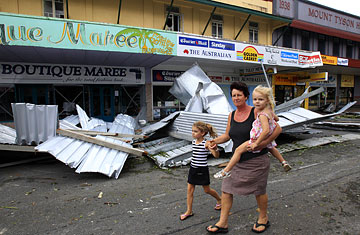
Helby Haines walks with her grandchildren Cienna Haines, left, and Claudia Haines, right, after Cyclone Yasi hit Tully, Australia, on Feb. 3, 2011
After ten years of drought and the worst floods in 50 years, Queensland had earned a breather. But by the start of February, residents of the eastern Australian state had been duly warned that yet another natural disaster was on its way, and people once again braced for the worst.
On Thursday, Cyclone Yasi, a Category 5 cyclone the size of Italy, ripped its way through coastal towns in northeast Australia in early dawn. It slammed into Mission Beach at speeds of roughly 186 mph (300 kph), ripping out trees, peeling back roofs, smashing through windows and flattening caravans. Evacuation centres were already overwhelmed with 6,000 people fleeing their homes the day before the storm landed. Late arrivals were turned back and told to seek shelter elsewhere. As evening fell in Queensland, 177,000 properties were still without power throughout in the region, and Queensland's Premier Anna Bligh has said that thousands will be left homeless.
Though Yasi was stronger than Hurricane Katrina, no serious injuries or deaths were reported as of Thursday evening local time. Bligh, however, hasn't ruled out potential fatalities as small towns in Yasi's path are still inaccessible. The physical and economic devastation will take time to assess. In aerial images of the area, the destruction looks relatively tame, with only 43 homes majorly damaged in the towns of Mission Beach, Tully Heads and Cardwell. Queensland Emergency Services Minister Neil Roberts, however, was reserving his optimism. "Until we get people on the ground making assessments property by property, they are preliminary assessments," he told reporters on Thursday.
Indeed, people on the ground have already described a more catastrophic scenario. "Telegraph poles have been knocked over and the wires are running on the ground," says Bill Shannon, the mayor of the Cassowary Coast Regional Council, who was driving back to his home on Mission Beach when he spoke to Time. "Trees have just been uplifted. I've just seen banana plantations that are completely flattened. Everything is getting worse and worse the further south I drive."
Though it will be days before the damage is tallied, Australian Prime Minister Julia Gillard has already announced that the reparations will come out of the federal budget. The unpopular flood levy of $1.8 billion, introduced last month to help pay for the Queensland floods and which will be funded by taxpayers, will not be raised further. Instead there will be $3.8 billion worth of budget cuts that will be deducted from climate-change programs. "We will meet the [Yasi] damages bill from the federal budget, it will require cutbacks in other areas. There is no point sugar-coating that," Gillard said to reporters in Canberra. The Australian Greens have voiced their discontent with this tactic. "That still continues to make no sense to me, when climate scientists are saying that the effect of climate change is that extreme events are going to happen more often and are going to be more severe," Greens' MP Adam Bandt told reporters.
The longer-term costs are equally hard to estimate. Fruit and vegetable prices, which have already risen by 12% since January, are expected to increase even more as banana and sugar plantations along the Queensland coast were decimated. Australia is the third largest sugar exporter in the world; raw sugar futures are now trading at a thirty-year high in the U.S. following predictions that Cyclone Yasi would destroy Australia's crop. "[The cyclone] has impacted a very large area," said Steve Greenwood, the CEO of Canegrowers Australia, a representative body for Australian sugarcane growers. "We are looking at costs of over half a billion dollars." Banana prices in Australia are also expected to rise dramatically, as 75% of the country's supply is likely to be affected. "We are looking at price jump more than 400 to 500%," says Luke Mathews the Commodity Strategist at Commonwealth Bank Australia.
Queensland is not unfamiliar with cyclones wreaking havoc on its coasts. Every summer, north Queensland enters a cyclone season, and unlike the January floods, the state is usually prepared. Since Cyclone Tracy devastated Darwin in 1974, building regulations have changed and evacuation schemes have been set in place for those living in cyclone-prone areas. It's a testament to those preparations that a storm like Yasi — the strongest cyclone on record to hit Australia — did not take a human toll. "We have satellites and better prediction systems than we did in the '70s," says Kevin Walsh, an associate professor at the School of Earth Sciences at the University of Melbourne. "If this happened 50 years ago the damage would have been much greater."
Walsh says Queenslanders were fortunate to escape unscathed. "It feels a bit funny referring to Queensland as lucky after they had a deluge of floods and a Category 5 cyclone, but I think if the cyclone had hit a more populated area things would have been much worse."
